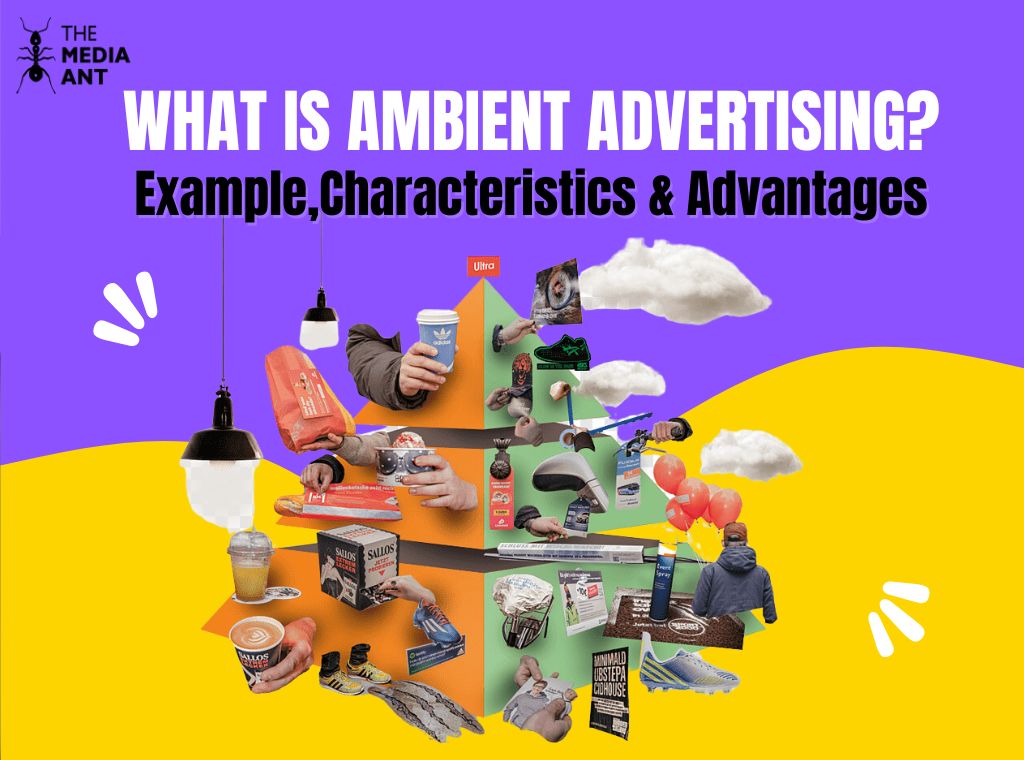What is Ambient Advertising?
Ambient advertising, also referred to as ambient media or ambient marketing, is a form of advertising that involves placing promotional messages or branded content in unconventional, unexpected, or non-traditional locations or formats. Unlike traditional advertising methods such as television commercials, print ads, or online banners, ambient advertising aims to integrate advertising messages into the environment in a way that engages and surprises the target audience.
5 Key Characteristics of Ambient Advertising
The key characteristic of ambient advertising is its ability to blend seamlessly with the surroundings, making it difficult to ignore while also creating a memorable impact. Ambient ads can take various forms, including:
1) Integration with the Environment: Ambient ads seamlessly blend into their surroundings, appearing as natural extensions of the environment rather than intrusive interruptions. This integration enhances the ad’s ability to capture attention without causing disruption.
2) Unconventional Locations: Ambient ads are placed in unexpected or non-traditional locations, such as sidewalks, park benches, staircases, or even public transportation vehicles. This unconventional placement helps the ads stand out and generates curiosity among the audience.
3) Creative and Innovative: Creativity lies at the core of ambient advertising. Marketers utilize innovative approaches, unique concepts, and out-of-the-box thinking to design ads that surprise, delight, and engage consumers in memorable ways.
4) Contextual Relevance: Ambient ads are strategically positioned to ensure contextual relevance. Marketers consider the target audience’s demographics, behaviors, and interests when selecting locations, ensuring that the ads resonate with the surrounding environment and the people who encounter them.
5) Memorable Experiences: Ambient advertising aims to create memorable brand experiences that leave a lasting impression on consumers. Whether through interactive installations, guerrilla marketing stunts, or captivating visuals, ambient ads strive to evoke emotions and spark conversations among the audience.
Advantages of Leveraging Ambient Advertising
1) Catches Attention: Ambient ads are different and surprising, so they grab people’s attention more effectively than regular ads.
2) Gets People Involved: Ambient ads often let people interact with them, making the experience more engaging and memorable.
3) Creates Lasting Impressions: They make people remember the brand or message because they’re unique and stick in their minds.
4) Gets Shared on Social Media: Because ambient ads are interesting and different, people like to share pictures and videos of them online, spreading the message even further.
5) Feels Relevant: Ambient ads are placed where people are already hanging out, so they feel more connected to what they see, making the message more meaningful to them.
Best Example of Ambient Advertising
One notable example of ambient advertising in India is the “Lickable” KFC advertisement campaign. In 2016, KFC India launched a unique and innovative campaign to promote its new “KFC Rice Bowlz” menu item.

The campaign involved placing large stickers on bus shelters in several cities across India, including Mumbai and Delhi. These stickers were designed to resemble pieces of fried chicken, complete with a tantalizing aroma. What made this campaign truly remarkable was the inclusion of a section on the sticker that people could actually like to taste the flavor of the KFC rice bowl.

By incorporating an interactive and sensory element into the advertisement, KFC India created a buzz-worthy campaign that garnered significant attention both online and offline. The campaign successfully engaged passersby in a fun and unexpected way, generating widespread curiosity and conversation about the new menu offering.
This innovative ambient advertising campaign showcased the effectiveness of thinking outside the box and leveraging creative concepts to capture the audience’s attention and drive brand awareness.
How to Effectively Position Ambient Ads?
To position ambient ads effectively, start by understanding your target audience and selecting strategic locations that align with their daily routines and interests. Ensure contextual relevance by integrating ads seamlessly into the environment while still standing out enough to capture attention.
Get creative with unconventional mediums and formats, and consider leveraging technology for added impact. Obtain necessary permissions and permits, and continuously monitor performance to optimize results. Overall, positioning ambient ads involves a strategic blend of creativity, relevance, and audience targeting to create memorable brand experiences.
FAQs on Ambient Advertising
Why use ambient marketing?
Ambient marketing offers several advantages over traditional advertising methods. It allows brands to stand out in a cluttered media landscape by leveraging unconventional locations and creative executions. Ambient marketing also fosters deeper engagement with the audience through interactive experiences, creating memorable brand interactions that leave a lasting impression.
What is the difference between outdoor and ambient advertising?
The main difference between ambient and outdoor advertising lies in their placement and approach. Outdoor advertising typically involves static or digital billboards, posters, and signage placed in specific locations like highways, bus stops, or buildings. On the other hand, ambient advertising focuses on integrating ads into everyday environments in unconventional ways, such as interactive installations, guerrilla marketing stunts, or product placements, often aiming for a more immersive and engaging experience for the audience.
How is ambient advertising different from traditional advertising?
Ambient advertising differs from traditional advertising in its approach and execution. While traditional advertising relies on familiar mediums like TV, radio, and print ads, ambient advertising integrates promotional messages into unconventional locations or uses unconventional methods to capture attention in everyday environments. This often involves creativity, innovation, and a focus on creating memorable brand experiences that resonate with the audience.
Is ambient advertising effective?
Yes, ambient advertising can be highly effective in capturing attention, creating memorable brand experiences, and driving engagement with the target audience. Its unconventional approach often leads to increased brand recall and recognition compared to traditional advertising methods. Additionally, the interactive and immersive nature of ambient ads can foster deeper connections with consumers, ultimately driving brand awareness and loyalty. However, like any form of advertising, the effectiveness of ambient advertising depends on factors such as creativity, relevance, and audience targeting.
How can I create an ambient advertising campaign?
To create an ambient advertising campaign, start by understanding your target audience and their preferences. Brainstorm creative ideas that will capture attention and resonate with your audience. Select strategic locations where your ads will be seen by your target demographic. Develop compelling content that effectively communicates your message and aligns with your brand identity. Consider leveraging technology or interactive elements to enhance the impact of your campaign. Obtain any necessary permissions or permits for placement. Finally, measure the performance of your campaign and make adjustments as needed to optimize results.
What is meant by ambient advertising?
Ambient advertising, also known as ambient marketing or guerrilla advertising, involves placing ads in unconventional, unexpected, and often creative locations or formats, aiming to surprise and engage audiences in their everyday environments. It blends seamlessly with the surroundings to capture attention and leave a memorable impression on viewers.
What is an example of ambient advertising?
An example of ambient advertising could be a cleverly placed ad on the steps of an escalator, where the steps themselves are designed to look like the teeth of a giant zipper, with the message “Unzip the Possibilities” promoting a clothing brand.
Why is ambient advertising used?
Ambient advertising is used to capture attention in unconventional ways, stand out from traditional advertising clutter, create memorable brand experiences, and engage audiences in unexpected environments, ultimately driving brand awareness and recognition.
What is another name for ambient advertising?
Another name for ambient advertising is “guerrilla advertising.”





